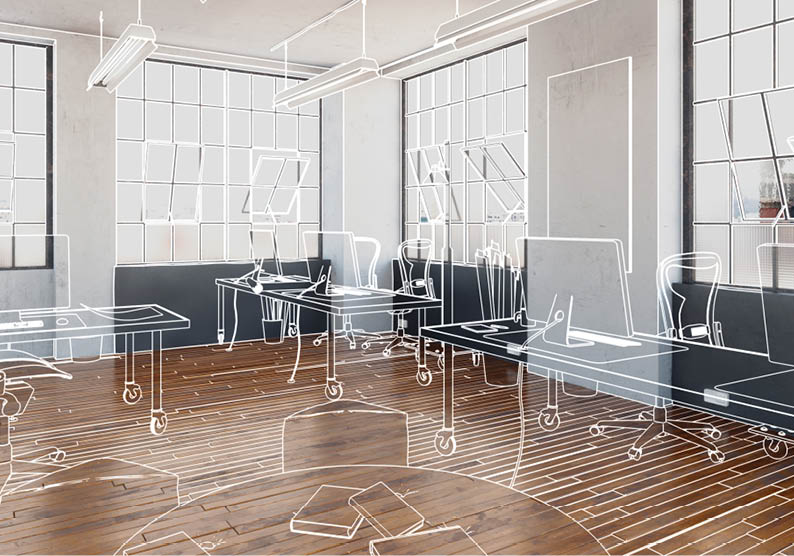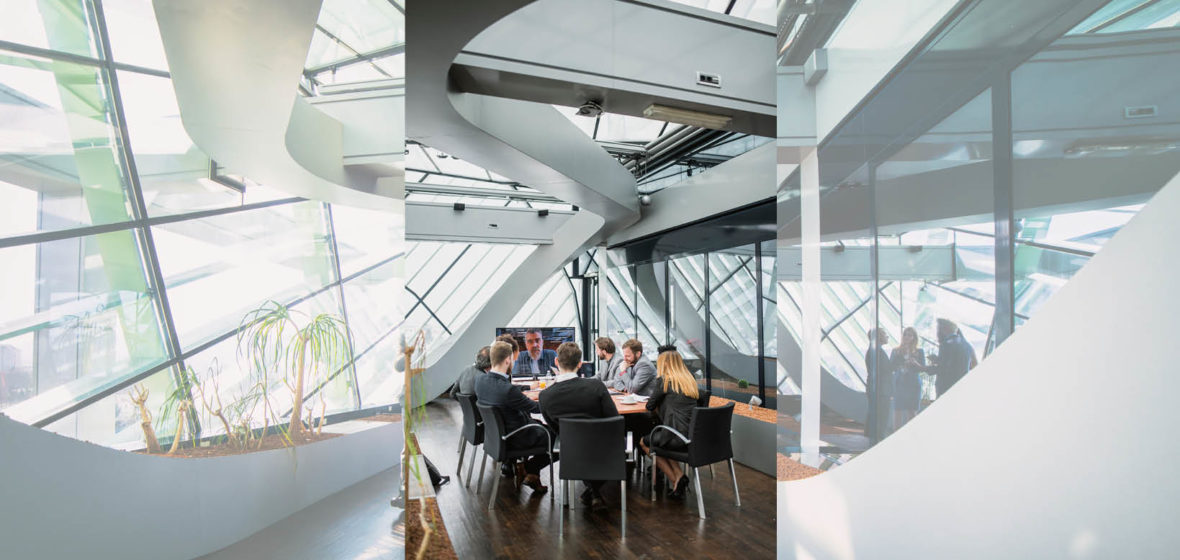After the upheaval of the pandemic, there’s no going back: hybrid work is here to stay. So, what sorts of physical changes should firms make to offices to realise the potential a hybrid work future offers?
As law firms look to the post-pandemic future of the profession, many envision – and, indeed, have implemented – hybrid work models that emphasise balance, agency and flexibility.
And it’s not just employee work patterns undergoing a paradigm shift. Moving between home and the office calls for profound changes to the design of company offices in response to this new way of working.
Gone is uniform adherence to one-size-fits-all office layouts. Instead, the arrival of hybrid work ushers in a new era of freedom to design physical offices that best reflect the needs of the firm and the preferences of the team.
Customising to suit
At Ashurst’s six Australian offices, as well as more than 20 overseas branches, the design of physical workspaces is changing. There are more spaces that facilitate collaboration, teamwork, confidential conversations and quiet time. Offices are smaller but more inviting, with opportunity for informal, casual engagement as well as structured, formal interactions.
“We have an overarching global hybrid working policy whereby we encourage everyone to work on a hybrid basis,” says Geoff Gishubl, partner and chief operating officer.
“As we progressively go around the world and redesign our offices, we’re looking to make the spaces reflect more the need for people to do different things and collaborate more often face-to-face in the office.”
The Melbourne office redesign was completed in June 2021, the Canberra team has just moved into new digs and the firm is currently revamping its Sydney site.
“We need to be more purposeful about how and when people connect face-to-face in the office because they’re not in there all the time,” Gishubl says. “We’re moving away from a more homogenous series of offices or work bays to a combination of spaces that reflect a variety of needs.”
Simon Pole, chief innovation and design officer at global workplace strategy, design and construction firm Unispace, is observing a similar shift among his law firm clients: demand for fewer individual desks and offices, or a smaller footprint for these, and an emphasis on creating more shared spaces.
“People are giving up the bits that they own in return for more ‘we’ spaces,” he says. “They’re getting more amenity in return. For example, they’re getting better wellness spaces. For one particular client, we’re creating flexible spaces for yoga, reflection zones and better café amenity, in return for employees relinquishing ownership and territoriality.”

Pole says he’s working with one law firm that’s chosen a smaller, open-plan space with a smattering of quiet rooms and collaboration rooms: “They’ve afforded themselves a better building at a higher rental rate because it’s less space.” Another will separate its workspace into a series of team-based neighbourhoods in lieu of assigned desks. Yet another has an open layout with micro-offices that can be booked for half or full days.
“We’re working with six law firms in the Australia and New Zealand region at the moment and they’re all different – the solutions are completely different,” Pole says.
No one size fits all
What’s striking about hybrid office design, even in a traditionally conservative field like law, is its heterogeneity. Instead of sticking to the rigid, one-dimensional formulas of old – say, identically sized offices for lawyers and the secretarial staff in open plan, or shared offices for juniors and individual offices for associates – there’s flexibility to respond to the work styles, patterns and preferences of individual workers, teams and firms.
“You might have a mergers and acquisitions team with 30 members, but you know from the data only 20 of them ever turn up at one point and they use a lot of meeting rooms, so they might need 20 desks,” says Domino Risch, principal and commercial and workplace sector leader at architecture, design and urban planning firm Hassell.
“You might also have a tax department who do most of their work over the internet or talking to clients on the phone. They’re very rarely out and about, so they might have 30 people and need 30 desks.”
Likewise, says Pole, “litigation and dispute resolution works very differently to insurance or someone working in corporate”.
“If we understand these teams deeper, we can design spaces that are more suited for the way they actually work – their processes, the way that they collaborate in real time, how big the teams are, what type of clients they service and the expectations around confidentiality.”
Talk of redesigning law firm offices to suit hybrid working patterns is often accompanied by angst about losing assigned desks or being sent to open-plan purgatory. But an insistence that hybrid office design equates to fixed assumptions about how a space should look and function puts its greatest benefits – flexibility and customisation – at risk.
“In a hybrid environment, that sort of uniform approach doesn’t work anymore because you’re creating spaces for specific types of work,” says Clare Gleghorn, CEO of communications and management firm Bastion Reputation.
Risch recommends viewing the potential of hybrid office design as a spectrum rather than a set of binary choices about assigned desks versus unassigned desks; individual offices or open-plan spaces.
“Hybrid is way of describing a space somewhere in between a fully enclosed working space and open plan. There’s no functional reason that lawyers can’t work in a non-allocated seating regime, so long as the right things are put in place like lots of storage and certainty about being able to find the people you want to work with.”
Gishubl agrees that the “question of assigned desks is an emotive issue in our industry” and says Ashurst is moving towards a model of assigned workspaces, rather than desks, which teams can use “how they like in the most efficient way”.
Risch says other unhelpful dichotomies, like a belief that people do most of their ‘thinking’ work at home and collaborative tasks in the office, or that everyone works 60 per cent of their time in the office and the rest at home, are equally problematic when it comes to designing offices for hybrid work.
“We all pretty much work in teams – most work is done as a collaborative effort – so the idea that you can partition your week off so that 40 per cent of it is private time and 60 per cent of it is collaboration time doesn’t really work.
“And not everybody has that feeling of home as quiet and peaceful,” Risch says, citing the experiences of people with young children and graduate lawyers living in shared housing.
“Hot tip: there is no one-size-fits-all. There’s no magical formula because hybrid working is about giving people autonomy of choosing where and when and how they do their job.”
“There is no one-size-fits-all. There’s no magical formula because hybrid working is about giving people autonomy of choosing where and when and how they do their job.”
What employees want
One of the main drivers of the widespread adoption of hybrid working is employees themselves and this desire for autonomy and agency. A 2021 report by Telstra based on data from more than 7000 organisations reveals 54 per cent of employees value the choice to work in hybrid ways the same, or more, than a five per cent pay rise. And more than half of Australian workers seek some form of hybrid working model, according to recent research by Bastion Reputation.
At Hall & Willcox, there are plans in place to design physical offices as “destinations” that encourage staff to turn up rather than work from home.
“Based on research and feedback, we think that it’s got to be a destination because people are pretty comfortable working from home,” says chief operating officer Sumith Perera.
“We’ve set our staff up well to be able to do this – they get all of the benefits of being able to work from home – so coming to work needs to provide a benefit over and above just being able to get your work done.”
He says the firm’s future workspaces will encourage collaboration, socialisation and other activities that are easier and more enjoyable when they’re done in person.
“We will continue to be an open-plan business, so we’re not going back to offices, but we need more collaborative spaces where people can jump into a small meeting space and work as a pair, and more project-type spaces where people come together for a short period of time to review progress on a project or on a client matter and then disperse to home or wherever to then get the work done.”
In particular, Perera says establishing a “baseline relationship” happens best in person, so there’s a particular focus on making the office attractive to new hires and junior staff.
“As people develop, perhaps there needs to be less in-person work.”
Such is the strength of the paradigm shift, and the changing power dynamic between employers and employees, that Pole says firms may benefit from thinking more like retailers.

“We need to understand what the consumers of office space actually want, need and desire, and design the spaces and the experiences to suit those more than we ever did before.
“If a firm believes that the office is the right place for their people to do their best work, then let’s design the office so it’s better than the alternate workspace – their house, their apartment or wherever they choose.”
The potential negative impact of sticking with traditional workplace models is enormous, according to a 2021 report by PwC Australia. Phenomena like the “Great Resignation”, where workers around the world are leaving or planning to leave their jobs in record numbers, mean the ball is very much in the court of employees.
“If you don’t think about these things as an employer, then you risk losing great talent because they will gravitate towards organisations that are willing to demonstrate that they’re open and willing to have these conversations,” says Gleghorn.
“That everyone will just come back and plug back into the workplace is not really understanding just what a fundamental shift people’s relationship with their work and their workplace has taken place.”
Managing the change
Creating an environment that entices staff back to the office starts with involving the team in discussions about how they want the office to look, feel and function. “It’s a pretty fundamental principle that we collaborate with our people before we make a decision as to precisely how to fit things out,” Gishubl says. “In Sydney, for example, we’ve got a core consultation group of about 30 people who are working on trying to figure out the various needs.”
He says this is just the first step in the change management process.
“It’s one thing to ask people what they think at the beginning, but you really need to take them on the journey through the process of change, addressing some of the prejudices lawyers may have about what they believe or have experienced the workplace to be. You can’t just talk to them about what they need, go away and design something, produce a new office and then walk away.”
Risch agrees that consulting with everyone at the firm to identify their preferences and modes of work, both internally and when meeting clients, then continuing to seek input and involvement throughout the entire process is key to the success of a new hybrid office design.
Above all, she says, the process is akin to a “redefinition of the covenant between the employer and the employee about how work will be done on an individual-to-individual level, but also on a team by team or practice group by practice group level, depending on the scale.
“There’s so much benefit that can be enjoyed by moving to a much more welcoming, joyful, efficient style of workplace without losing all the things we know we need in an office.”




